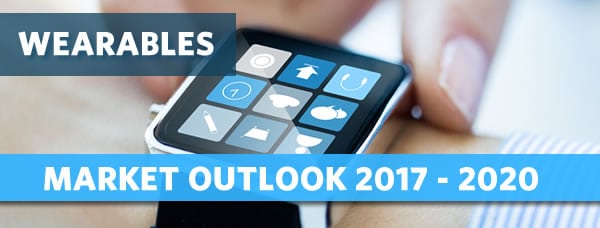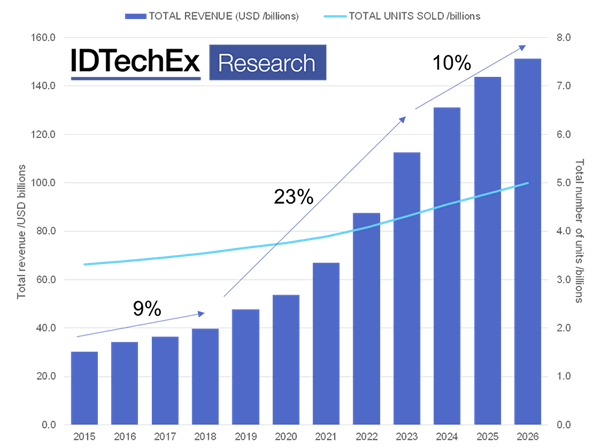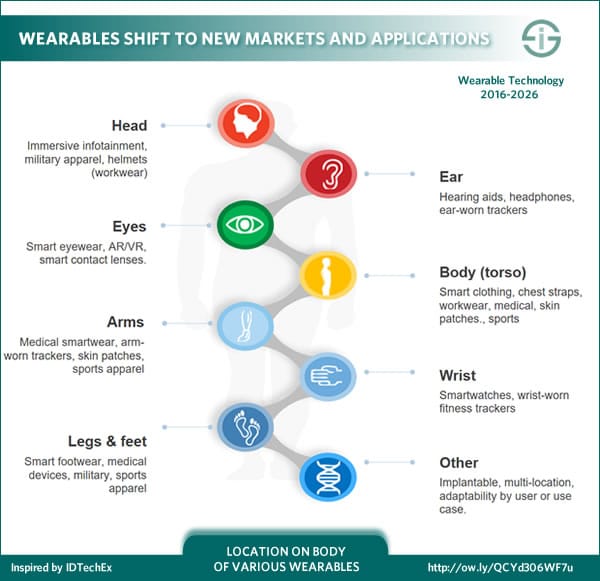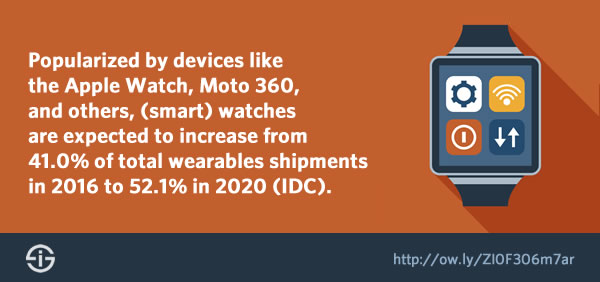Where is wearable technology heading and what can we expect from the wearables market? End 2015, IDC expected that the main drivers of the market would be the newer generations of smarter wearable devices, whereas until then mainly basic wearables were the most popular.
Smart wearables are the next step in the Consumer Internet of Things (CIoT) wearable evolution. They are smart in many senses, among others from the perspective of independent processing power, making them less dependent from smartphones and able to run apps. Yet, they still need some time and we expect smarter wearables for consumers to hit the market at more affordable and interesting conditions in the second half of 2017, early 2018.
Wearables are also used, albeit in different forms and shapes and on various possible parts of the body, in a context of the Industrial Internet of Things (IIoT), where they are, among others used, for safety. Also in the healthcare industry and in the professional sports sector, various forms of wearables are used a lot. In other words: it’s certainly not just a consumer technology category.

Early 2016 Accenture was pessimistic about the wearables market and the Consumer Internet of Things market overall, from the consumer electronics dimension as mentioned before.
A lack of a ‘wow’ factor, too expensive devices and consumer fears regarding security and data privacy were among the many challenges for consumer IoT devices. Time for an update and some forecasts.
Forecasts and drivers regarding wearables
Despite the end 2016 security woes it seems as if things are about to change, certainly in specific categories of wearables.
In July 2016, IDTechEx research claimed that the market of wearable technology will reach over $30bn in 2016 and from then on continue to grow in three stages:
- a limited but two-digit growth of 10 percent growth until 2018 when the market would be worth over $40bn, next a
- accelerated growth with a yearly growth of 23 percent through to over $100bn by 2023 and,
- finally, again slower growth (11 percent) to reach over $150bn by 2026. But that is still quite some time away.
In the announcement, IDTechEx defined wearable technology as any electronic product which is designed to be worn on the person.

Wearables are shifting to new sectors
In other words: the research looks at wearable technology beyond the consumer perspective and in areas such as the industrial Internet where it can fulfil many functions as mentioned, among others in the context of health and safety.
The research of IDTechEx covers these as well. Moreover, the first topic in the Table of Contents says enough: “Wearables – the hype is over and shifting to new sectors”.
If we look at the various parts of the body where wearables can be worn and even by implanted (e.g. medical), we are moving to wearables and smartwear everywhere.

The future of the wearables market: watches remain important drivers but look at eyewear for revenue
According to a March 2016 announcement from IDC worldwide shipments of wearables would surpass 200 million units in 2019.
Among the drivers of this growth: the emergence of smarter watches and smartwatch growth. Watches and wristbands would reach a total of 100 million shipments in 2016, while smart clothing, smart eyewear and other wearable products together were expected to reach 9.8 million units by the end of 2016. By 2020, the latter category would double its share but the main wearables market focus would remain on smart watches.
In a June 2016 update, IDC confirmed that watches and wristbands would remain key drivers in the wearables market and stated it expected wearables shipments to reach 213.6 million units globally in 2020.
In that announcement, the research firm also said that eyewear was to be an important growth market. By 2020 it will only account for 10 percent of wearable device shipments but, more importantly, it would account for 40 percent (!) of the total revenue of the wearables market. So: watch that eyewear segment.

2016, however clearly was still for basic wearables while smart wearables didn’t find their place in the market yet and the market even stalled.
Basic wearables grew 48.8 percent in the second quarter of 2016 (compared with Q2 of 2015), while shipments of smart wearables declined 27.2 percent year over year in that same quarter according to a September 2016 update. And it seems basic will still rule for some time.
Expect more forecasts on specific types of wearables and other devices and applications in the Consumer Internet of Things soon.
Top image: Shutterstock – Copyright: Syda Productions – All other images are the property of their respective mentioned owners.

